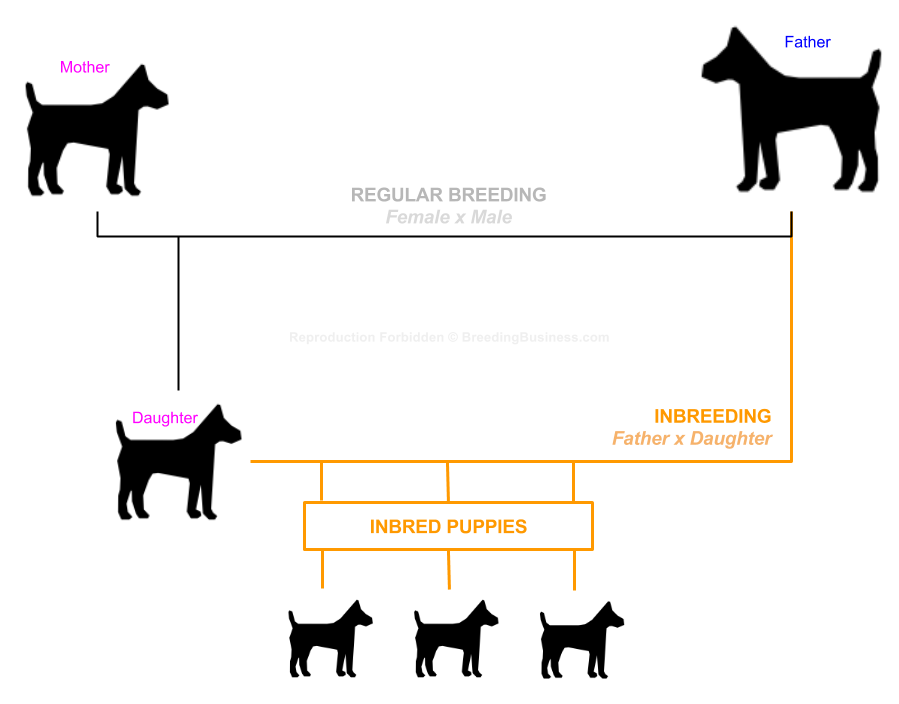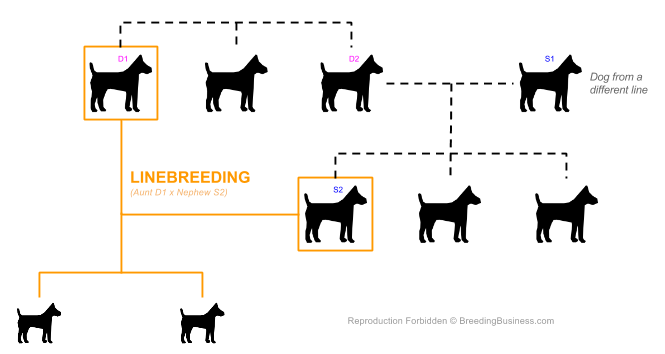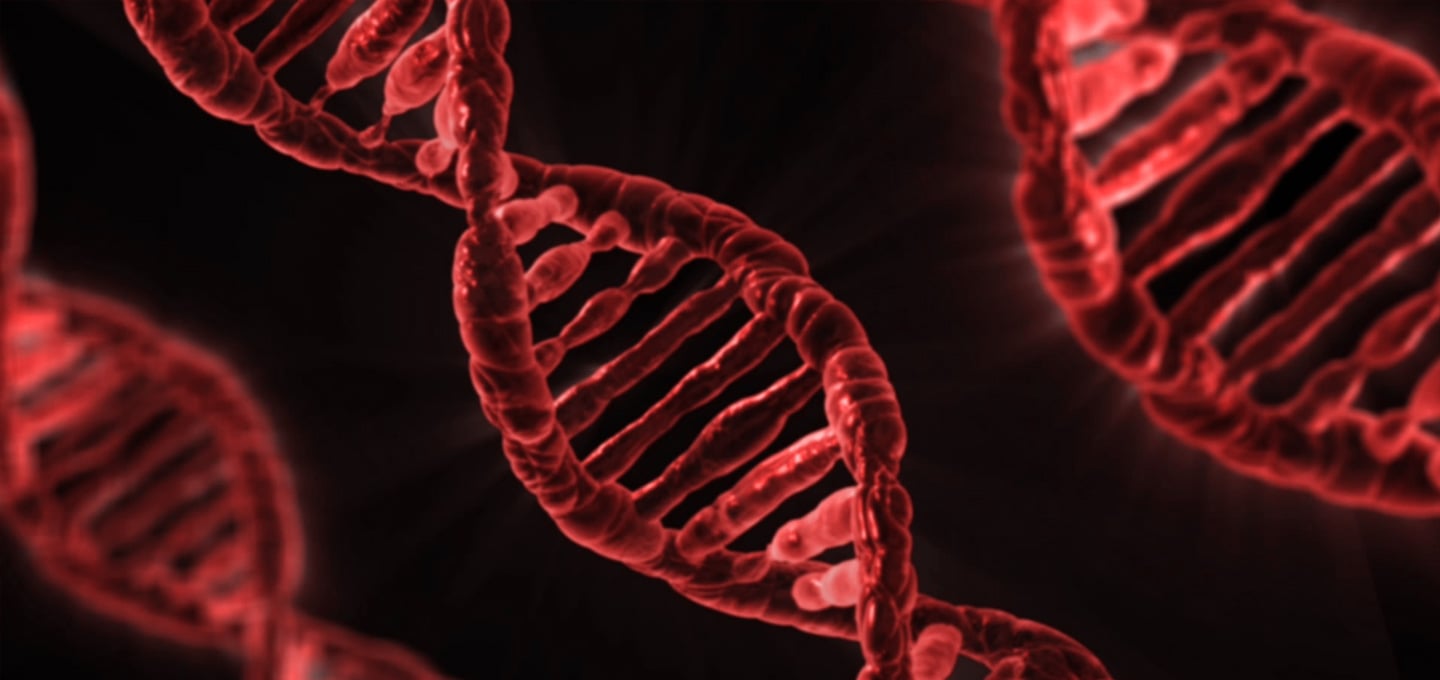Inbreeding is the mating of closely related dogs, sometimes over many generations. For example father to daughter, brother to sister, half-brother to half-sister, mother to son, etc. The ultimate goal of inbreeding is to fix and preserve the characteristics that the breeder is looking for by increasing homozygosity (it is the degree of genetic similarity between two individuals) in the dog’s genetic pool.
Inbreeding is a process that intensifies the animal’s traits and characteristics, both good and bad, at each and every generation. The ultimate goal of inbreeding is to fix and preserve the traits that the breeder is looking for by increasing homozygosity in the dog’s genetic pool.

Why Is Inbreeding Used In Dog Breeding?
In some situations, inbreeding is required, for example, to create a new breed or to re-create a nearly extinct breed. Indeed, in both cases, the very few specimens available at the start will need to mate together several times to grow the number of specimens within the breed. Because dog breeding is mainly assortative breeding, without the sorting of individuals by trait, a breed could not be established, nor could poor genetic material be removed.
The more sound the bloodline the more successful inbreeding will be, this is why the parents and their ancestors must be as void of structural faults and health problems as possible to avoid (randomly) fixing the wrong genes and fixing and preserving hereditary diseases. Before starting an inbreeding plan, you will need to study as many generations as possible before mating the dogs to make sure the bloodline is genetically sound. It will take time to research so many generations but you will have to go through this process to avoid accidents.
Inbreeding vs Linebreeding vs Backbreeding
Both linebreeding and backbreeding are some forms of inbreeding. Although there is no clear rule to separate Linebreeding from Inbreeding, here is the common agreement:
- Inbreeding is the mating of close relatives (between brother x sister, parent x puppy, half-brother x half-sister)
- Linebreeding is the mating of relatively distant relatives (between cousins, uncle x niece)
- Backbreeding is the mating of one parent with its descendants over several generations (father with a bitch, then the same father with its one daughter, granddaughter, etc.)

For more information, feel free to read our article on linebreeding and the one on backbreeding.
Inbreeding Coefficient
The coefficient of inbreeding is an equation which expresses the expected percentage of homozygosity arising from a given Sire and Dam, meaning, the probability of how genetically similar they are. To perform this equation, the breeder needs a fully documented pedigree over as many generations as possible.
The UK Kennel Club offers a page where you can provide the Sire’s and Dam’s name to find out what is the degree of inbreeding. You can also find a few calculators online where you can quickly find out the result of a breeding, PedScope is a software for Windows and OS X users offering a free trial.
[adwithin]
Those tools offer accurate pedigree analysis through various and complex mathematical functions (Wright’s equation, for example), assisting you with various measures of genetic diversity, statistics for groups of individuals, relationship matrices, reports and many other metrics. They are not required in order to inbreed as nothing replaces your very own knowledge of the bloodlines involved and the study of the pedigrees mating.
Grading up is a dog breeding strategy used by many new breeders to progressively increase homogeneously the overall quality of their bloodline. It boils down to investing in a very high-quality stud dog that will then be line-bred to his best offspring. Here as well, there is a risk of high inbreeding coefficient and therefore requires a lot of caution from the owner.
Why Is Inbreeding Controversial?
The BBC produced two documentaries on dog inbreeding titled Pedigree Dogs Exposed and Pedigree Dogs Exposed – Three Years On that document the negative health consequences of excessive inbreeding. They give the example of a Cavalier King Charles part of a breed where the direction is to reinforce the small size of the dog but as a result of such intensive assortative breeding, the skull’s size of some dogs became too small for their brain, resulting in severe neurological conditions.
This type of breeding is not recommended to novice breeders and newcomers in a breed. Before starting such an enterprise, you will need to seek bits of advice from your Kennel Club, other breeders, and breed specialists such as competition judges. You will end up having the worse bloodline if you start with a poor broodstock and inbreed them. Most issues will appear years after the birth of the puppies and your reputation will be broken, so are the lives of the puppies you produced.
The UK Kennel Club’s decision on Inbreeding
Because inbreeding does not only improve the puppies’ features positively but also negatively, The Kennel Club decided a few years ago to stop registering litters from a close mating, between mother and son, father and daughter, or brother and sister. They, however, said that in exceptional circumstances, they would allow it if welfare reasons were clearly and scientifically identified.

10 comments on “Definition and Meaning of Inbreeding in Dogs”
[…] is a form of inbreeding and while there is no clear rule separating both terms, linebreeding commonly denotes breeding […]
[…] breeding is another form of inbreeding where one dog (S) is mating with another specimen (D) to then mate with the strongest from that new […]
I have a lady inquiring about breeding her bitch with my stud. After looking at the pedigree, her bitch’s grandfather is my males great grandfather. Is it exceptable to breed these two dogs?
Hello angie, yes it is fine as long as there wasn’t too much or too frequent inbreeding in that grandfather already.
some would say yes! others will get up set with you!!! find the right person!!!!!!! that can scientifically identified that its right or wrong to do
I’m not a purebred breeder, and I’m new to this. My female is mostly ShihTzu and partly Bichon Frise. My male is an unrelated ShihTzu/Lhasa Apso with a bit of Yorkshire Terrier thrown in. I’d like to breed these two and keep their daughter for breeding, because my female is getting older. In this case, will it be safe to breed father to daughter? Please advise.
It wouldn’t be safe to breed these two dogs as such unless genetic homework done and confirming otherwise.
We are getting a mini Goldendoodle puppy in a few weeks from a reputable breeder and just found out that the sire is the son of the dam. DNA and genetic testing have been done on both. I think this is only the First or second litter of these pairs. Should we be concerned?
My mini poodle miscarried her 2nd litter, she was clear on brucella. Now after a little more than 2 months she mated couple of times with my toy poodle. they got a beautiful and healthy first liiter.
What are the chances that she will be pregnant that soon? and to have a healthy litter? Super concerned.
I’m actually not trying to breed. What happened was our female dog was in heat and matted with her son. I’m worried, I’m scared… Is it normal are the puppies going to be okay or should I terminate the pregnancy I need some advice, please.